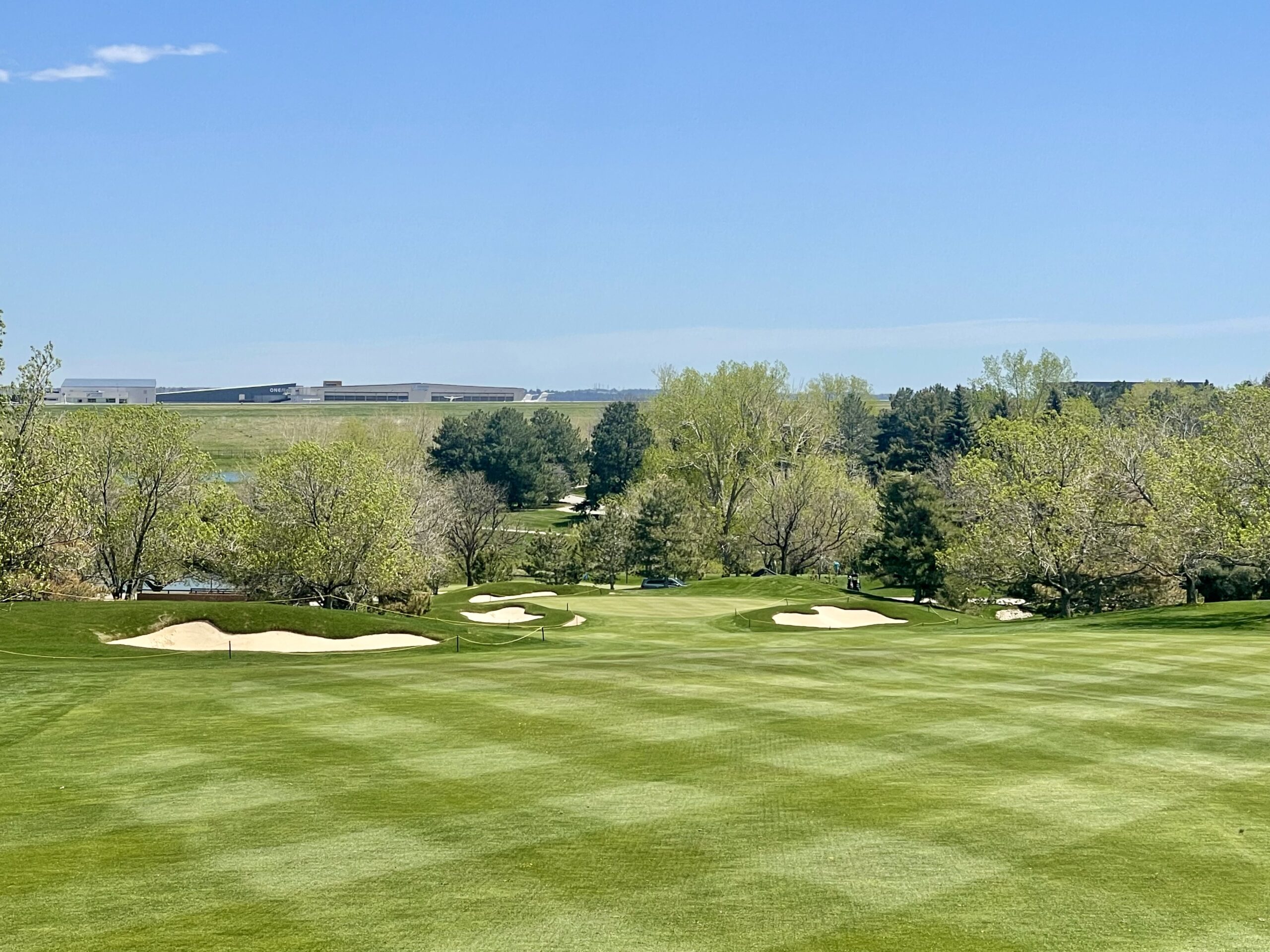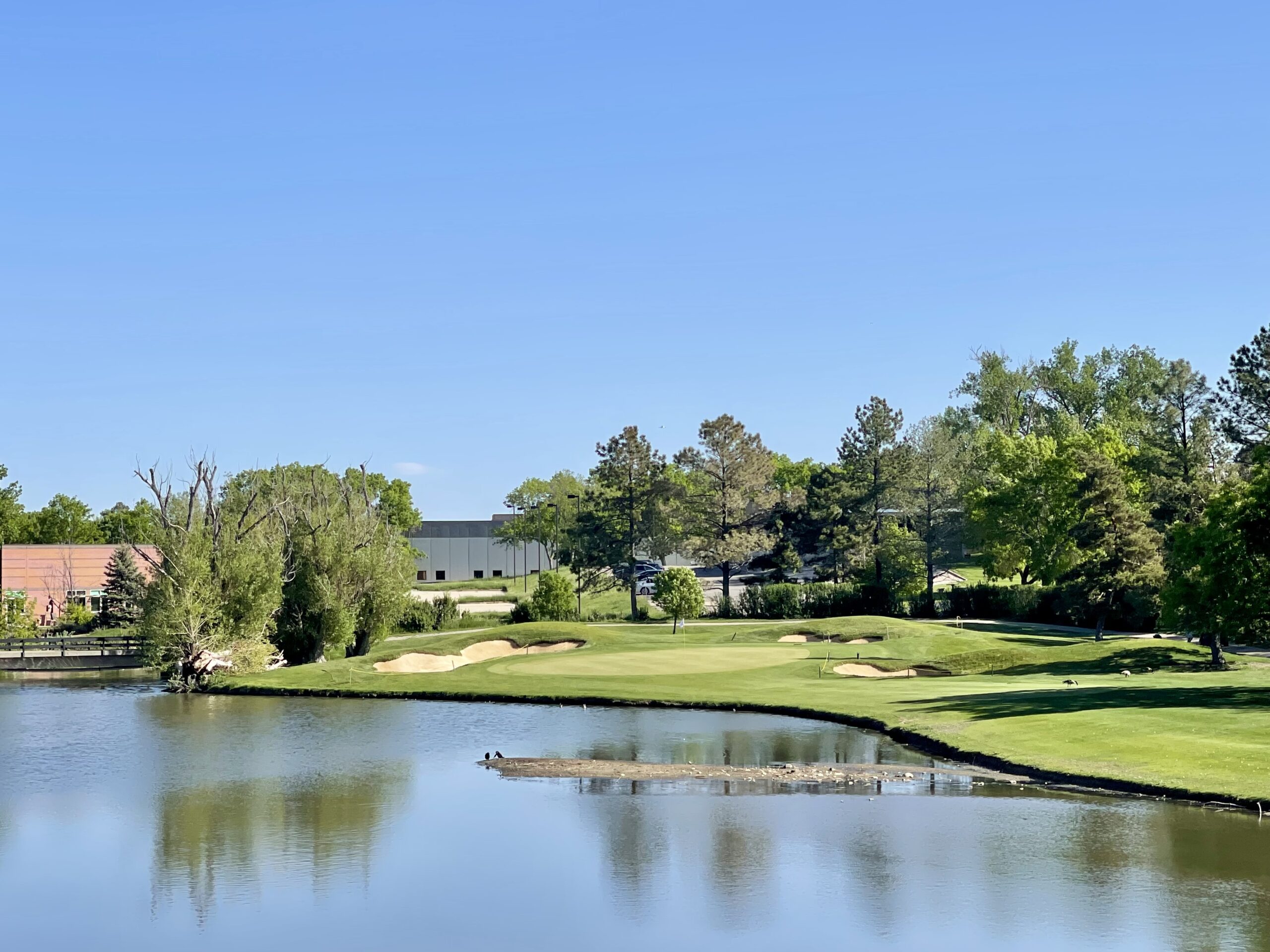
The course’s Hole 12 following renovations. (Courtesy The Club at Inverness)
The Club at Inverness has completed $750,000 in renovations to the golf course’s bunkers and fairways, the first phase in plans to modernize and upgrade the club.
The bunker renovations, which included the deletion of eight bunkers and the reshaping of the remaining 65 bunkers to improve playability of the course, expand turf area and improve the overall visual appearance of the course.
Dave Steinmetz, director of golf at the country club in unincorporated Arapahoe County, said the original 73 bunkers were mundane, with the majority of them looking virtually identical to one another.
The redesigns shrunk the total bunkers space from 75,000 square feet to about 45,000 square feet, Steinmetz said. The bunkers also were moved closer to the greens and fairways to expand playable turf area.
“The old bunkers were all the same size and shape,” Steinmetz said. “There were no characteristics to them. (The renovations) gave it characteristics that improve playability and decreased the amount of general maintenance needed.”
Steinmetz said he expects that costs for needed bunker maintenance will decrease by 50 percent, with time spent on it dropping as well.

The course’s Hole 15 following renovations. (Courtesy The Club at Inverness)
The Club at Inverness hired Denver’s Dye Designs Group for the project. Senior Design Associate Matt McGarey said the old bunkers had tree root encroachment and the sand had started to lose its shape.
Working alongside his mother, Dye Designs Group Principal Architect Cynthia Dye McGarey, and contractor Total Turf Golf Services, they started using the Better Billy Bunker system on the bunkers, which entails using gravel beneath the sand instead of liners to hold the sand in place and prevent snags from rakes and clubs.
They also replaced the sand to give them a more uniform feel, though the bunkers now have smaller and unique shapes, McGarey said.
“Before you never knew what lie you were hitting out of,” McGarey said. “ It could’ve been rocks, sand, dirt, mud. The new sand and Better Billy Bunker system with gravel beneath it allows for better drainage and holds the sand in shape. … The course has a new look and the playability has improved immensely.”
Steinmetz said this was the first phase in ongoing plans to renovate The Club at Inverness, which was constructed in 1974. The bunker renovations were one step toward modernizing and upgrading the club. Steinmetz said the club is deciding this fall what its next major project will be.
“Our members have absolutely loved the renovations we’ve done,” Steinmetz said. “The course looks more modern, even just from the bunkers. … This was just phase one.”

The course’s Hole 12 following renovations. (Courtesy The Club at Inverness)
The Club at Inverness has completed $750,000 in renovations to the golf course’s bunkers and fairways, the first phase in plans to modernize and upgrade the club.
The bunker renovations, which included the deletion of eight bunkers and the reshaping of the remaining 65 bunkers to improve playability of the course, expand turf area and improve the overall visual appearance of the course.
Dave Steinmetz, director of golf at the country club in unincorporated Arapahoe County, said the original 73 bunkers were mundane, with the majority of them looking virtually identical to one another.
The redesigns shrunk the total bunkers space from 75,000 square feet to about 45,000 square feet, Steinmetz said. The bunkers also were moved closer to the greens and fairways to expand playable turf area.
“The old bunkers were all the same size and shape,” Steinmetz said. “There were no characteristics to them. (The renovations) gave it characteristics that improve playability and decreased the amount of general maintenance needed.”
Steinmetz said he expects that costs for needed bunker maintenance will decrease by 50 percent, with time spent on it dropping as well.

The course’s Hole 15 following renovations. (Courtesy The Club at Inverness)
The Club at Inverness hired Denver’s Dye Designs Group for the project. Senior Design Associate Matt McGarey said the old bunkers had tree root encroachment and the sand had started to lose its shape.
Working alongside his mother, Dye Designs Group Principal Architect Cynthia Dye McGarey, and contractor Total Turf Golf Services, they started using the Better Billy Bunker system on the bunkers, which entails using gravel beneath the sand instead of liners to hold the sand in place and prevent snags from rakes and clubs.
They also replaced the sand to give them a more uniform feel, though the bunkers now have smaller and unique shapes, McGarey said.
“Before you never knew what lie you were hitting out of,” McGarey said. “ It could’ve been rocks, sand, dirt, mud. The new sand and Better Billy Bunker system with gravel beneath it allows for better drainage and holds the sand in shape. … The course has a new look and the playability has improved immensely.”
Steinmetz said this was the first phase in ongoing plans to renovate The Club at Inverness, which was constructed in 1974. The bunker renovations were one step toward modernizing and upgrading the club. Steinmetz said the club is deciding this fall what its next major project will be.
“Our members have absolutely loved the renovations we’ve done,” Steinmetz said. “The course looks more modern, even just from the bunkers. … This was just phase one.”
